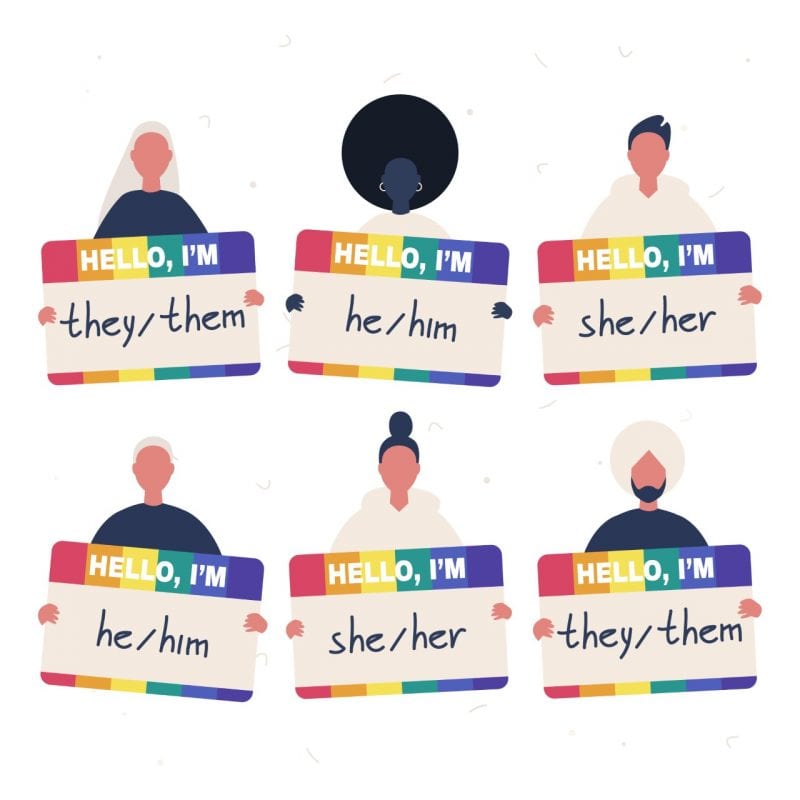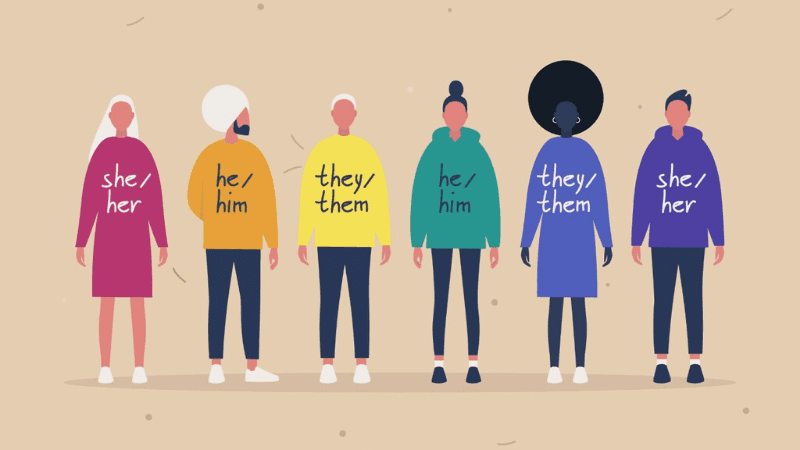Recently, there has been a lot of discussion on social media about teaching personal pronouns, especially when related to identity. Tooley from @growingwithmxt, Ace from @teachingoutsidethebinary, and Brittany from @thesuperheroteacher joined together to debunk some of the common myths as well as highlight the importance of teaching personal pronouns in the classroom, regardless of grade level. The authors want to point out that while the graphics only include she, he, and they, there are many other personal pronouns (ze, ey, etc.), and one pronoun is not more important than the other.
What do we mean by teaching personal pronouns?
In general, we’re talking about the ways we use pronouns to refer to one another, in the classroom and beyond. For example, Ace and Tooley both teach their personal pronouns when they introduce themselves to their students. For many students, this is the first time they have ever had a teacher who uses they/them/theirs pronouns, so understanding how those pronouns tie into identity is important. We can also teach students to respect pronouns by asking for students to privately provide theirs. This has become a more common practice in middle and high schools.
It’s important to note that suicide rates among sexual-minority adolescents are higher than their cisgender or heterosexual peers.
More specifically recent studies show that “sexual minority youth were 3.5 times as likely to attempt suicide as heterosexual peers. Transgender adolescents were 5.87 times more likely, gay and lesbian adolescents were 3.71 times more likely and bisexual youth were 3.69 times more likely than heterosexual peers to attempt suicide.”
Inclusion in the classroom facilitates a culture of acceptance and lowers suicide rates. A way to start this process is looking at the arguments made against teaching pronouns related to identity and clearing up any misunderstandings.
Let’s take a look at five of the most common misconceptions:
1. Pronouns are only for older students.
According to the American Academy of Pediatrics, most children have a “stable sense of their gender identities” by age four. This identity may evolve as they get older, but it is important to give students language to help understand and affirm their identities early on. Pronouns can help students feel congruent in their identities, meaning there is harmony with how they express themselves and how they feel on the inside. Plus, there are many people in the world who use pronouns such as they, ze, etc. It’s important to respect all people and pronouns, so teaching students about personal pronouns early can help normalize them and reinforce the idea of respect.

2. It’s too hard to integrate pronouns and identity into curriculum.
It is easier today than ever before! Not only can we integrate this discussion into a morning meeting, there are many picture books and ways to discuss this topic during your ELA block! Below you’ll find a list of books you can use to either discuss pronouns or gender identity with your learners. Other integration ideas: mentor sentences with the singular they pronoun, math word problems that use the singular they to identify a person, and utilizing the singular they when the gender of a person is unknown.
List of Books:
-
-
- They She He Me: Free to Be! by Maya Christina Gonzalez
- It Feels Good to Be Yourself: A Book About Gender Identity by Theresa Thorn
- Neither by Airlie Anderson
- Phoenix Goes to School: A Story to Support Transgender and Gender Diverse Children by Michelle Finch
- They, She, He Easy As ABC by Maya Christina Gonzalez
- More book recommendations, including middle school!
-
3. The singular they isn’t grammatically correct.
Actually, that’s not the case! In 2019, Merriam-Webster added “used to refer to a single person whose gender identity is nonbinary” to define they. Further, dictionary.com explains that they is a nominative pronoun to indicate a nonbinary or gender-neutral subject of a verb instead of he or she. But let’s not stop there! Did you know that APA style endorses the use of they as a singular third-person pronoun? That means it’s officially considered grammatically correct in scholarly writing to use the singular they!
4. Students will get confused.
Not at all! As mentioned before, students have a stable sense of their gender identity at age four. It is important to introduce pronouns and then practice using them! You can help the class practice using different pronouns by practicing on inanimate objects (like a stuffed animal or pillow). Practice using different pronouns in different scenarios with the class and practice what to do when we mess up someone’s pronouns (correct yourself and move forward). It is a fun activity and allows students to feel more comfortable saying and using all pronouns.
5. I don’t have LGBTQ+ students in my class, so I don’t need to teach identity or pronouns.
Based on data collected from The Williams Institute, it is estimated that at least 4.5 percent of the population is LGBTQ+. That number is likely much higher since many people are not out publicly and we are constantly evolving and growing our understanding of sexuality and gender. Therefore, in the span of a 30-plus-year career, it is almost certain that, at some point, teachers will have LGBTQ+ students. Some students may come out, some may never come out, and that’s okay. We never want to make assumptions about students and their identities, so incorporating these concepts into class, even in small ways, can make a big difference. Finally, it all goes back to fostering a sense of respect for all people and identities.
Now that we’ve addressed these myths and misconceptions, it’s important that we, as educators, take a look at the bigger picture. Ultimately, using personal pronouns in your classroom is going to create a safe space for all students. We know that learning in an environment where a student can feel true to themselves is key when it comes to confidence, growth, and self-esteem. Therefore, it’s our job to protect our students and make them feel comfortable in the atmosphere in which we teach. Choosing the pronouns you teach based on what you feel comfortable with actually does the opposite. It isolates students while simultaneously forcing them to question their identity. Let’s allow our mindset about pronouns to evolve and grow. Every student in your classroom deserves to be proud of their identity and have their personal pronouns respected.
